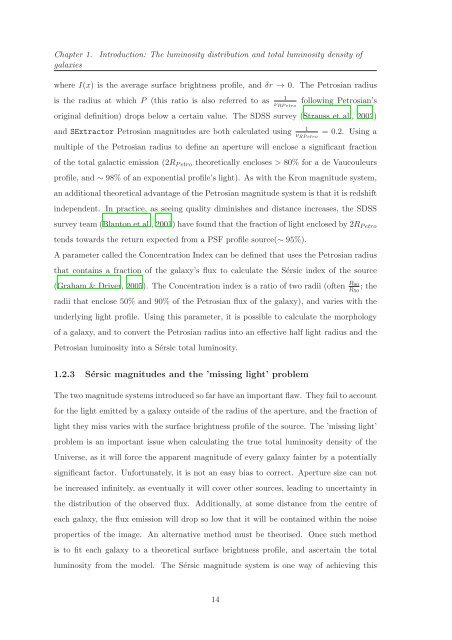David Thomas Hill PhD Thesis - Research@StAndrews:FullText ...
David Thomas Hill PhD Thesis - Research@StAndrews:FullText ...
David Thomas Hill PhD Thesis - Research@StAndrews:FullText ...
Create successful ePaper yourself
Turn your PDF publications into a flip-book with our unique Google optimized e-Paper software.
Chapter 1. Introduction: The luminosity distribution and total luminosity density of<br />
galaxies<br />
where I(x) is the average surface brightness profile, and δr → 0. The Petrosian radius<br />
is the radius at which P (this ratio is also referred to as 1<br />
νRPetro<br />
following Petrosian’s<br />
original definition) drops below a certain value. The SDSS survey (Strauss et al., 2002)<br />
and SExtractor Petrosian magnitudes are both calculated using 1<br />
νRPetro<br />
= 0.2. Using a<br />
multiple of the Petrosian radius to define an aperture will enclose a significant fraction<br />
of the total galactic emission (2RPetro theoretically encloses > 80% for a de Vaucouleurs<br />
profile, and ∼ 98% of an exponential profile’s light). As with the Kron magnitude system,<br />
an additional theoretical advantage of the Petrosian magnitude system is that it is redshift<br />
independent. In practice, as seeing quality diminishes and distance increases, the SDSS<br />
survey team (Blanton et al., 2001) have found that the fraction of light enclosed by 2RPetro<br />
tends towards the return expected from a PSF profile source(∼ 95%).<br />
A parameter called the Concentration Index can be defined that uses the Petrosian radius<br />
that contains a fraction of the galaxy’s flux to calculate the Sérsic index of the source<br />
(Graham & Driver, 2005). The Concentration index is a ratio of two radii (often R90;<br />
the R50<br />
radii that enclose 50% and 90% of the Petrosian flux of the galaxy), and varies with the<br />
underlying light profile. Using this parameter, it is possible to calculate the morphology<br />
of a galaxy, and to convert the Petrosian radius into an effective half light radius and the<br />
Petrosian luminosity into a Sérsic total luminosity.<br />
1.2.3 Sérsic magnitudes and the ’missing light’ problem<br />
Thetwomagnitudesystemsintroducedsofarhaveanimportantflaw. Theyfailtoaccount<br />
for the light emitted by a galaxy outside of the radius of the aperture, and the fraction of<br />
light they miss varies with the surface brightness profile of the source. The ’missing light’<br />
problem is an important issue when calculating the true total luminosity density of the<br />
Universe, as it will force the apparent magnitude of every galaxy fainter by a potentially<br />
significant factor. Unfortunately, it is not an easy bias to correct. Aperture size can not<br />
be increased infinitely, as eventually it will cover other sources, leading to uncertainty in<br />
the distribution of the observed flux. Additionally, at some distance from the centre of<br />
each galaxy, the flux emission will drop so low that it will be contained within the noise<br />
properties of the image. An alternative method must be theorised. Once such method<br />
is to fit each galaxy to a theoretical surface brightness profile, and ascertain the total<br />
luminosity from the model. The Sérsic magnitude system is one way of achieving this<br />
14

















